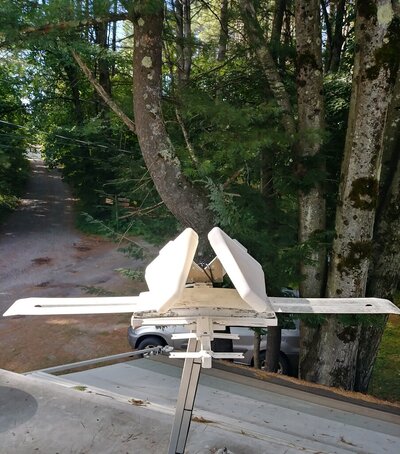Ex-Calif
Well-known member
I got a lesson from AT&T today.
When I was remote from a tower (about 4 miles and some trees) I bought a signal booster and installed it in the RV. Antenna on the roof, the box in a cabinet and the repeating antenna inside the coach. About 6 weeks ago I moved into a rental house for a period while my new MH is awaiting delivery.
I moved Marvin to the rental house about 4 weeks ago.
Today I got a knock on the door and there was an AT&T tech outside asking if I had an antenna as they were getting signal noise in my area. I was not thinking about the repeater in the RV but as he explained that it had to be close it dawned on me that I did. He went to his car and got his scanner and I led him to the RV. The screen was like a B&W oscilloscope and you could see that the signal was "dirty" like 3/4 scale on the screen.
I reached in the door and unplugged the power to the unit and the signal immediately cleared to flat line. In fact I had been only getting like 1 Verizon bar on my phone which I thought was bad because I am in the "city" of Live Oak. After he left I checked my phone and I am not getting 3 bars!
He explained that in most RV installations the receiving antenna and the transmitting antenna are too close together and they simply screw each other up and create noise. This also explains why I did not perceive any signal improvement after installing this thing. There really was no guidance on how far apart to set the antennas as all the install pictures showed a house and they probably just presume the separation will be OK.
I probably will rethink the install and try and get the transmitting antenna as far away from the receiving antenna as I can before I use it again.
He also reminded me that intentionally jamming towers is a federal bust but "with a guy like you" there won't be any suspicion of that. I asked him if people were complaining and he said that the first thing was that 911 calls were getting "dropped" - Yikes, that's not good. He also said there aren't many guys doing his job as he came from Orlando to Live Oak to troubleshoot this.
Lessons learned...
When I was remote from a tower (about 4 miles and some trees) I bought a signal booster and installed it in the RV. Antenna on the roof, the box in a cabinet and the repeating antenna inside the coach. About 6 weeks ago I moved into a rental house for a period while my new MH is awaiting delivery.
I moved Marvin to the rental house about 4 weeks ago.
Today I got a knock on the door and there was an AT&T tech outside asking if I had an antenna as they were getting signal noise in my area. I was not thinking about the repeater in the RV but as he explained that it had to be close it dawned on me that I did. He went to his car and got his scanner and I led him to the RV. The screen was like a B&W oscilloscope and you could see that the signal was "dirty" like 3/4 scale on the screen.
I reached in the door and unplugged the power to the unit and the signal immediately cleared to flat line. In fact I had been only getting like 1 Verizon bar on my phone which I thought was bad because I am in the "city" of Live Oak. After he left I checked my phone and I am not getting 3 bars!
He explained that in most RV installations the receiving antenna and the transmitting antenna are too close together and they simply screw each other up and create noise. This also explains why I did not perceive any signal improvement after installing this thing. There really was no guidance on how far apart to set the antennas as all the install pictures showed a house and they probably just presume the separation will be OK.
I probably will rethink the install and try and get the transmitting antenna as far away from the receiving antenna as I can before I use it again.
He also reminded me that intentionally jamming towers is a federal bust but "with a guy like you" there won't be any suspicion of that. I asked him if people were complaining and he said that the first thing was that 911 calls were getting "dropped" - Yikes, that's not good. He also said there aren't many guys doing his job as he came from Orlando to Live Oak to troubleshoot this.
Lessons learned...

